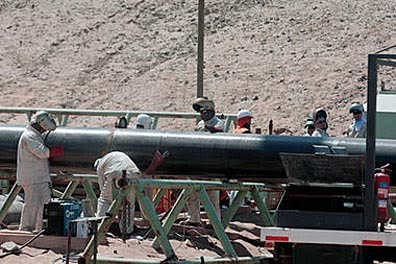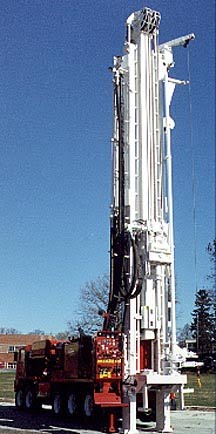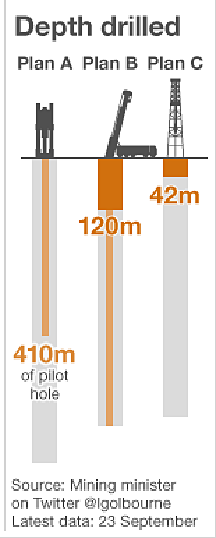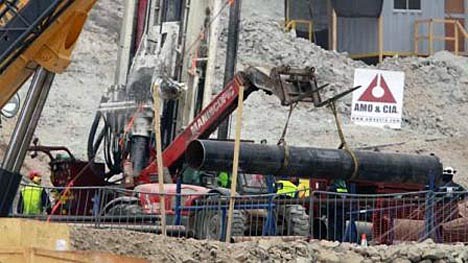The Chilean Miners - Nearing a Rescue
Posted by Heading Out on October 11, 2010 - 7:02pm
The rate of progress in rescuing the miners from the copper mine in Chile continues to be better than expected. After the completion of the rescue shaft on Saturday, it was inspected, and the top 300 ft was considered to be possibly unstable and so has had to be lined with a metal casing. This is somewhat similar to that used in oilwells, except that it does not have to be water-tight and can be hung from the top, through a lip that extends outwards, again without need for a seal. This liner was inserted in 20 segments, and is only needed for the first 300-ft since a survey of the rest of the 2,300 ft long shaft has shown that the rock around it is solid, and does not need support.


There were three different drills used to try and create the rescue shaft. The first of these, a Strata 950 was brought to the site on August 22nd, and drilled its own access bore, which would then be subsequently reamed to the necessary diameter for the rescue capsules. As a back-up a second drill, a Schramm T-130 was brought to the site at the beginning of September (the fourth) . In contrast with the first drill, which was drilling its own access borehole, this unit was set up to ream one of the existing boreholes (of which there were 3). By doing this, and reaming the hole in two stages, rather than just one, progress could be considerably faster. The initial diameter of the hole was 6 inches, this was first reamed out to 12-inches, and then to the final 26-inches. After set-up the benefit of the two-stage operation became evident early on, with the T-130 being able to ream the initial bore out to 12-inches by the 17th of September. Fifty days after the collapse of the mine tunnel, progress for what was now three different operations, was shown in this graphic.

Plan C, a drilling rig which is drilling a hole at full diameter from the beginning was set-up later, but has been making very good progress, and is being continued to provide a possible back-up in case something goes wrong with the initial shaft.
One of the concerns with the existing shaft is that, as a result of the way that the hole was drilled, it is not straight but has a number of curves in it. These are not severe, but could possibly cause a problem with the cage. By this morning the lining had been completed, and the infrastructure is being assembled over the shaft to be able to wind the cage in and out of the mine.

It is now expected that the cage will be tested today to ensure that it can easily move up and down the shaft, and that the miners will be able to start being lifted out of the mine starting at 3 am Wednesday morning. And in a more recent story the cage has been reported as having been able to move down the shaft without any problems .




I really do hope they all get out safely. 26 inches doesn't sound like a whole lot of room for a cage with a man inside. I heard that it may take up to 90 mins for each lift which is along time to not move. I would need some strong sedatives. Best of luck to them all.
I've seen widely varying accounts of how long the ascent should take. A recent CNN article stated:
"Beginning six hours before the rescue starts, the miners will be switched to a diet of liquids, vitamins and minerals ahead of their trip to the surface. Each trip is expected to take about 15 minutes."
http://www.cnn.com/2010/WORLD/americas/10/11/chile.trapped.miners/index....
Does that seem a bit on the quick side?
Most man-riding cages in shafts move at much higher speeds than this. However the shaft is not straight, but through the actions of the drill spirals as it goes down. Thus, as the cage rises, it is likely to spin several times. If they move too fast, apart from the risk of jamming the cage, they could possibly get the miner too disorientated.
HO, is the 26 inches a standard man-riding cage diameter or is this just the minimum (and presumably fastest) way top reach them? The avergage coffin has more room than this so I would imagine the ride to be quite unpleasant. My claustrophobia is rising just thinking about this.
If you were stuck down there, you would fit into a 26" cage. I mean you WOULD fit. As far as a coffin goes I believe that might not be a very good choice even if equipped with all mod cons, I would pick the cage. Maybe they should send down some Japanese railway station attendants, complete with white gloves.
NAOM
I think the time of 25 min for lifting each miner was given on PBS news. Elapsed time from start of one miner to start of next is guessed at about an hour. In addition to the thirty-three. There are two volunteers from the rescue team going down to be certain that there are people down there who know how to handle this particular cage. So there will be two trips down and thirty-five trips up. The fellow on PBS guessed that the people moving would start at midnight tuesday - wednesday and not be finished until about dawn on thursday.
Of course, if people get dizzy and start up chucking, they likely will go slower.
they're down 2000 feet. 2000ft/15 minutes = 133 ft/min, or 2 feet/second. Go take a ride on an elevator, and go up ten floors, about 10 ft/floor, and if it takes you 50 seconds, that's how fast the miners will be coming up.
Stream, you are a wonder! What a good analogy.
cheers Juan
There will be over 2000 feet of cable so that is a fair size winch; they wont want to build any momentum rather will want to go slow enough to sense any snag before they jerk something loose. I wonder if the have a safety engagement if the cable goes slack?
I saw a note to the effect that they would start by lowering a medic in the basket.
I had to read the story carefully - it *sounds* like they are nearly ready to go now, but they won't begin the actual rescue for about another 24 hours.
Time of commencement of rescue. From what I have read that is planned for midnight CLST (Chile Summer Time) Tuesday October 12. CLST is UTC/GMT -3HRS. So at UTC 03:00 the action starts. See you then cheers Juan.
Based on what we saw in the recent US rescue, I'd bet that if you asked the miners to sort the rescue order, there would be no medically indicated difference between the order they would pick, and the order a doctor fresh on the scene would pick. They've been together a long time, and know who really needs to be in the front of the line. (And I'd bet there'll be a small scrum to be the last man out.)
It'll still be a great moment when that last man is out of the mine.
"(And I'd bet there'll be a small scrum to be the last man out.)"
Yes a number of miners want to be in the Guinness Book of World Records as having been underground the longest in a mine disaster.
My bet is on the guy who has his wife AND girlfriend waiting at the top. Maybe he'll just elect to stay where he is......
Yeah - except to avoid precisely that embarrassing situation, either the wife or the girlfriend (not yet decided, they'll be drawing straws shortly) will be one of the volunteers going down initially...then he's equally damned below or above...
:)
/s
I saw a story on the news that they would start the rescue at 7PM Eastern.
It appears that the first miner is on the way to the surface.
Video feed here:
http://www.cnn.com/video/flashLive/live.html?stream=stream2
Edit: False alarm - it was another test of the basket.
From the BBC
http://www.bbc.co.uk/news/world-latin-america-11489439
without pop ups.
First rescuer going down at 02:18 UTC.
NAOM
Touch Down!!!
They don't seem to be in a hurry to get the first miner on the way up.
I gather they need to get the miners fitted with heart monitors and give them sedatives before they send them up.
It is kind of striking - it looks pretty cold up top, and down in the mine they are shirtless due to the heat.
Blast-Off!
";-^)
Chi Chi Chi, le le le!
This sure beats the original estimates of getting these guys out by Christmas.
I'm watching the first rescuer go down, live. As a former submariner (who once spent 105 days submerged) I can sense what these guys are feeling. I expect they'll enjoy their 'rebirth'.
This episode in mining rescue is a great lesson in what we are capable of, and also our limitations.
These guys were only about 2000 feet away from the surface for over two months.
......and, for the record, last miner out.
Well done!
.